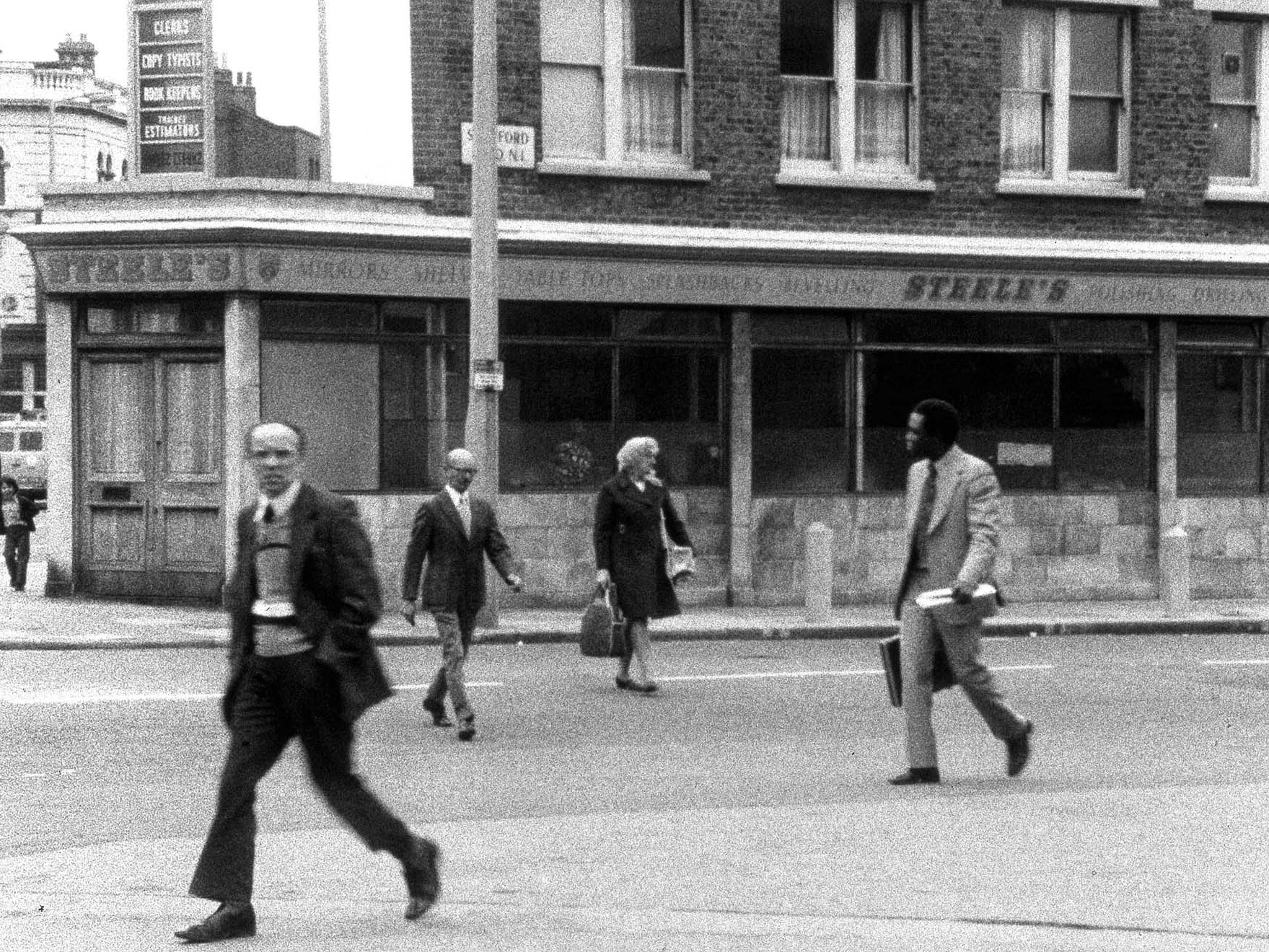
A short film in which a director's voice appears to be directing all the action on a busy London street.
“The major part of this week’s show is by a young film-maker who is something of a ‘new face’. Though he has shown a film in a group programme at the Co-op before, and one of his films, Associations, was recently seen on BBC2’s ‘First Picture Show’, this is the first chance to look at a number of his films in one go. His work is extremely interesting, accomplished, and has a surprising variety. As well as Associations which weaves a complex game of word-image puns with entertaining wit, he will show William and the Cows, one of the most surreal films I have ever seen; Leading Light, a rather fine short film about sunlight, artificial light, and exposure levels; and Subjective Tick-Tocks, about measured time, rhythm, and camera movement. The programme will have the first screening of his newest film, The Girl Chewing Gum, which promises to be as good viewing as the rest ... A lively show full of ideas.”
Malcolm Le Grice1
“The films of John Smith create a world from the “simple” experiences of living, breathing and being a filmmaker or artist in a particular place and time. Smith’s often humorous films produced over the last 30 years have inventively documented and probed his immediate surroundings, often not even moving much beyond the front door of his various abodes in a small area of East London (predominantly Leytonstone). Nevertheless, it would be wrong to describe Smith’s films as overly delicate, preciously insular or purely personal – assignations that the previous description might suggest – as his work sees within the minutiae of familiar surroundings a range of philosophical, aesthetic, technical and quotidian challenges and revelations that extend far beyond the realm of much other comparable cinema. [...] In film after film, Smith explores the cracks within and the tribulations of the world he confronts everyday, taking a closer look at and often transforming (verbally, associatively, just by observing from a different angle) things like a pane of glass, the discolorations of a mouldy ceiling, a hospital water-tower, the archaeology of an ancient toilet, an old shepherd’s proverb, or a work he was unhappy with some 20 odd years before. In the process, he makes us look more closely, not just at his films and the cinema generally, but our own surroundings, the everyday world that engulfs us but that we probably routinely dismiss as a suitable subject for contemplation, art and imagination.”
Adrian Danks2
“Believe it or not, I was really surprised to discover that the people in the background were being directed in their actions. Even the dog was instructed to piss up a lamp-post. Until then, I had assumed that extras in street scenes were real passers-by going about their business. I was already a filmmaker and I thought to myself how naïve I had been about the ‘realism’ of fiction films. The Girl Chewing Gum came out of the shock I felt at the power of the illusion of cinema.”
John Smith3
“In The Girl Chewing Gum a commanding voice over appears to direct the action in a busy London street. As the instructions become more absurd and fantasised, we realise that the supposed director (not the shot) is fictional; he only describes – not prescribes – the events that take place before him. Smith embraced the ‘spectre of narrative’ (suppressed by structural film), to play word against picture and chance against order. Sharp and direct, the film anticipates the more elaborate scenarios to come; witty, many-layered, punning, but also seriously and poetically haunted by drama’s ineradicable ghost.”
A.L. Rees4
“The Girl Chewing Gum offers a playful yet trenchant exploration of the role that language – and particularly voice-over – plays in the production of filmic meaning and asserts the absolute impossibility of immediacy and neutrality. But despite its anti-illusionist criticality, the film remains deeply engaged with narrative and humour, two terms not often associated with British avant-garde cinema of the 1970s. Indeed, it was Smith’s concern that the film might be taken simply as a joke that led him to conclude the work with several humourless minutes, what he has referred to as ‘thinking time’.”
Erika Balsom5
Nick Bradshaw: The unedited aspects seems quite radical not only in the context of your earlier works, but also given how heavily processed TV has become.
John Smith: They’re wilfully simple. I’ve got myself into trouble at film festivals when I’ve won prizes for those films, particularly in Cork when I won the main prize for Museum Piece. I had to make a speech, and I said that it gave me particular pleasure to get a prize for this film because I’m a great believer in economy, and this film cost €7, or the price of one DV tape. And afterwards I had so many really angry young filmmakers coming up to me, saying ‘I borrowed £10,000 to make my film, and yours is a load of shit!’
John Smith in conversation with Nick Bradshaw6
- 1Malcolm Le Grice, untitled film listing, Time Out, 5–11 March 1976, p.64.
- 2Adrian Danks, “On the Street where You Live: The Films of John Smith”, Senses of Cinema, 2005.
- 3John Smith, on Truffaut’s La Nuit américaine (1973), in Catherine Elwes, “Trespassing Beyond the Frame”, in Mark Cosgrove and Josephine Lanyon (eds.), John Smith: Film and Video Works, 1972–2002, Bristol 2002, pp.65–6.
- 4A.L. Rees, A Directory of British Film & Video Artists, 1995.
- 5Erika Balsom, “The Girl Chewing Gum, 1976 by John Smith”, Tate Research Publication, 2015.
- 6Nick Bradshaw, “John Smith: of process and puns”, Sight and Sound, web exclusive.

